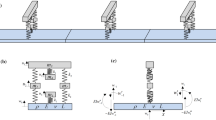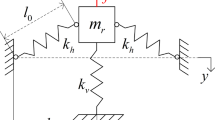Abstract
The present study deals with analyzing the dynamic behavior of a smart beam coupled with piezoelectric materials in the unimorph and bimorph configurations connected to resonant shunt circuits. The resonant shunt circuit connection is applied to promote and passively modulate the vibration and flexural wave propagation attenuation. A Spectral Element Method (SEM)-based approach for the periodic smart structure is developed that is capable of efficiently analyzing various configurations of periodicity and piezoelectric attachments in a generic framework. The wave attenuation is obtained based on the Transfer Matrix Method (TMM). Numerical analyses reveal that the effective wavenumber presents local attenuation behavior at the same frequencies of the vibration as per the shunt design, indicating the shunt circuit’s impedance associated with tuned frequency. The internal resonance characteristics of the resonant shunt circuits and their effects on the beam response are investigated in detail. The proposed periodic smart beam system along with the spectral element approach for analyzing the dynamics and wave propagation behavior of such systems, lays out further potential avenues for designing more complex configurations of smart structures and multifunctional metamaterials.














Similar content being viewed by others
References
B. Yan, K. Wang, Z. Hu, C. Wu, X. Zhang, Shunt damping vibration control technology: a review. Appl. Sci. 7(5), 494 (2017)
D.J. Leo, Engineering Analysis of Smart Material Systems (Wiley, New Jersey, 2007), pp. 1–7
C.H. Cheng, S.C. Chen, Z.X. Zhang, Y.C. Lin, Analysis and experiment for the deflection of a shear-mode PZT actuator. Smart Mater. Struct. 16, 230–236 (2007)
A. Singh, T. Mukhopadhyay, S. Adhikari, B. Bhattacharya, Voltage-dependent modulation of elastic moduli in lattice metamaterials: emergence of a programmable state-transition capability. Int. J. Solids Struct. 208–209, 31–48 (2021)
R.L. Forward, Electronic damping of vibrations in optical structures. J. Appl. Opt. 18(5), 690–697 (1979)
J.A. Gripp, D.A. Rade, Vibration and noise control using shunted piezoelectric transducers: a review. Mech. Syst. Signal Process. 112, 359–383 (2018)
F.A. Viana, J.V. Steffen, Multimodal vibration damping through piezoelectric patches and optimal resonant shunt circuits. J. Braz. Soc. Mech. Sci. Eng. 2006, 293–310 (2006)
N.W. Hagood, A.V. Flotow, Damping of structural vibrations with piezoelectric materials and passive electrical networks. J. Sound Vib. 146(2), 243–268 (1991)
L. Airoldi, M. Ruzzene, Design of tunable acoustic metamaterials through periodic arrays of resonant shunted piezos. New J. Phys. 13, 113010 (2011)
C.L. Davis, G.A. Lesieutre, An actively tuned solid-state vibration absorber using capacitive shunting of piezoelectric stiffness. J. Sound Vib. 232, 601–617 (2000)
S.-Y. Wu, Piezoelectrics shunts with a parallel r-l circuit for structural damping and vibration control. in Symposium on Smart Structures and Materials (San Diego), (2020), pp. 259–269
J.J. Hollkamp, Multimodal passive vibration suppression with piezoelectric materials and resonant shunts. J. Intel. Mat. Syst Str. 5, 49–57 (1994). https://doi.org/10.1177/1045389X9400500106
J.J. Hollkamp, R.W. Gordon, An experimental comparison of piezoelectric and constrained layer damping. Smart Mater. Struct. 5, 715–722 (1996)
C.H. Park, Vibration control of beams with negative capacitive shunting of interdigital electrode piezoceramics. J. Vib. Control 11, 331–46 (2005)
J. B. Min, K. P. Duffy, A. J. Provenza, Shunted piezoelectric vibration damping analysis including centrifugal loading effects. https://ntrs.nasa.gov/citations/20110016111 (2011)
K. Marakakis, G.K. Tairidis, P. Koutsianitis, G.E. Stavroulakis, Shunt piezoelectric systems for noise and vibration control: a review. Front. Built Env. 5, 64 (2019)
M.I. Hussein, M.J. Leamy, M. Ruzzene, Dynamics of phononic materials and structures: historical origins, recent progress, and future outlook. Appl. Mech. Rev. 66(4), 40802 (2014)
S. Gonella, M. Ruzzene, Homogenisation of vibrating periodic lattice structures. Appl. Math. Model. 32, 459–482 (2008)
M. Neubauer, J.E. Wallschek, Vibration damping with shunted piezoceramics: fundamentals and technical applications. Mech. Syst. Signal Process. 2013, 36–52 (2013)
A. Sénéchal, Réduction de vibrations de structure complexe par shunts piézoélectriques : application aux turbomachines. Doctoral Thesis, Conservatoire national des arts et metiers - CNAM. Français (2011)
N. Sergey, N. ShevtsovSergey, A N. Shevtsov, A. N. Solovev, Helicopter rotor blade vibration control on the basis of active/passive piezoelectric damping approach, Conference: Physcon, Catania, Italy (2009)
B. Seba, J. Ni, B. Lohmann, Vibration attenuation using a piezoelectric shunt circuit based on finite element method analysis. Smart Mater. Struct. 2006, 15–20 (2006)
J. Min, K. Duffy, A. Provenza, Shunted piezoelectric vibration damping analysis including centrifugal loading effects. 51st AIAA/ASME/ASCE/AHS/ASC structures, structural dynamics, and materials conference, Orlando, Florida (2010)
S. Kazi, A. Assarry, M.Z.M. Zain, M. Mailah, M. e Hussein, Experimental implementation of smart glove incorporating piezoelectric actuator for hand tremor control. Wseas Trans. Syst. Control 5, 443–453 (2010)
F. Casadei, M. Ruzzene, L. Dozio, K. Cunefare, Broadband vibration control through periodic arrays of resonant shunts: experimental investigation on plates Smart Mater. Struct. 19, 015002 (2009)
C. Sugino, M. Ruzzene, A. Erturk, Design and analysis of piezoelectric metamaterial beams with synthetic impedance shunt circuits. IEEE/ASME Trans. Mechatron. 23–5, 2144–2155 (2018)
C. Sugino, M. Ruzzene, A. Erturk, An analytical framework for locally resonant piezoelectric metamaterial plates. Int. J. Solids Struct. 182–183, 281–294 (2020)
G. Wang, J. Cheng, J. Chen, Y. He, Multi-resonant piezoelectric shunting induced by digital controllers for subwavelength elastic wave attenuation in smart metamaterial. Smart Mater. Struct. 26, 2 (2017)
D. Casagrande, P. Gardonio, M. Zilletti, Smart panel with time-varying shunted piezoelectric patch absorbers for broadband vibration control. J. Sound Vib. 400, 288–304 (2017)
Y.Y. Chen, G.L. Huang, C.T. Sun, Band gap control in an active elastic metamaterial with negative capacitance piezoelectric shunting. ASME. J. Vib. Acoust. 136(6), 061008 (2014)
J.F. Doyle, Wave Propagation in Structures: A Spectral Analysis Approach, 2nd edn. (Springer, New York, 1997)
U. Lee, Spectral Element Method in Structural Dynamics (Wiley, Singapore, 2009)
M.R. Machado, S. Adhikari, J.M.C. Dos Santos, Spectral element-based method for a one-dimensional damaged structure with distributed random properties. J. Braz. Soc. Mech. Sci. Eng. 40(91), 415 (2018)
M. Dutkiewicz, M.R. Machado, Measurements in situ and spectral analysis of wind flow effects on overhead transmission lines. Sound Vibr. 53(4), 161–175 (2019)
M. Dutkiewicz, M.R. Machado, Dynamic response of overhead transmission line in turbulent wind flow with application of the spectral element method. IOP Conf. Ser.: Mater. Sci. Eng. 471(524), 2019 (2019)
M. Machado, M. Dutkiewicz, C. Matt, D. Castello, Spectral model and experimental validation of hysteretic and aerodynamic damping in dynamic analysis of overhead transmission conductor. Mech. Syst. Signal Process. 136(1), 106483 (2020)
S. Adhikari, T. Mukhopadhyay, X. Liu, Broadband dynamic elastic moduli of honeycomb lattice materials: a generalized analytical approach. Mech. Mater. 157, 103796 (2021)
T. Mukhopadhyay, S. Adhikari, A. Alu, Theoretical limits for negative elastic moduli in subacoustic lattice materials. Phys. Rev. B 99, 094108 (2019)
U. Lee, J. Kim, Dynamics of elastic-piezoelectric two-layer beams using spectral element method. Int. J. Solids Struct. 37, 4403–4417 (2000). https://doi.org/10.1016/S0020-7683(99)00154-7
U. Lee, J. Kim, Spectral element modeling for the beams treated with active constrained layer damping. Int. J. Solids Struct. 38(32–33), 5679–5702 (2001)
Z.-J. Wu, F.-M. Li, Dynamic properties of three-dimensional piezoelectric Kagome grids. Waves Random Compl. Media 25(3), 361–381 (2015)
M.R. Machado, A.T. Fabro, B.B. Moura, Spectral element approach for flexural waves control in smart material beam with single and multiple resonant impedance shunt circuit. J. Comput. Nonlinear Dyn. 10(1115/1), 4047389 (2019)
M.R. Machado, A. Appert, L. Khalij, Spectral formulated modelling of an electrodynamic shaker. Mech. Res. Commun. 97, 70–78 (2019)
B. Jaffe, R. Cook, H. Jaffe, Piezoelecfric Ceramics (Academic Press, New York, 1971)
M.A. Clementino, F. Nitzsche, C. De Marqui, Experimental verification of a semi-active piezoelectric pitch link for helicopter vibration attenuation, in 25th AIAA/AHS Adaptive Structures Conference (2017)
W. Zhong, F. Williams, On the direct solution of wave propagation for repetitive structures. J. Sound Vib. 181, 485–501 (1995)
B. B. Moura, M. R. Machado, Vibration control using piezoelectric connected with shunts circuits, in: WCCM-ECCOMAS2020. https://www.scipedia.com/public/Moura-Machado-2021a (2021)
Acknowledgements
TM would like to acknowledge the support received through the Science and Engineering Research Board (Grant no. SRG/2020/001398), India. M.R. Machado would like to acknowledge the support received through the Fundação de Apoio a Pesquisa do Distrito Federal-FAPDF (Grants no. 00193-00000766/2021-71 and 00193-00000826/2021-55) and CNPq (Grant Universal 404013/2021-0).
Author information
Authors and Affiliations
Corresponding author
A Transfer matrix method
A Transfer matrix method
Transfer matrix method allows us to exploit the dynamic stiffness matrix of a single piezo-beam for analyzing periodic arrangements of such beams. The spectral transfer matrix method [32] is an analytical spectral approach of the system in the state-space form to directly obtain the transfer matrix of the structure. From dynamic system relationship, a frequency-domain state-vector equation is obtained as
where \({\mathbf {A}}\left( \mathbf {\omega }\right) \) is the system coefficient matrix with \([2n \times 2n]\) degrees of freedom, and \(\hat{{\mathbf {y}}}(x)=\{\hat{{\mathbf {d}}}\ \ \ \hat{{\mathbf {F}}}\}^{\mathbf {T}}\) is the state vector with \(\hat{{\mathbf {d}}}\) as the spectral nodal displacements and \( \hat{{\mathbf {F}}}\) the spectral nodal forces vectors. The general solution of Eq. (40) for a structural element of length L is given by
where \({\mathbf {T}}\left( \mathbf {\omega }\right) ={\mathbf {e}}^{{\mathbf {A}}L}\) is the transfer matrix, in its exponential form. If all eigenvectors of the matrix \({\mathbf {A}}\) are linearly independent, the transfer matrix can be written as
where \({\mathbf {T}}\left( \mathbf {\omega }\right) \) relates the left (l) state vector \({\mathbf {q}}_l\) with the right (r) state vector \({\mathbf {q}}_r\) of the unit-cell [46]
\({\mathbf {A}}=e^\mu \) is the corresponding eigenvector matrix and \({\mathbf {q}}\) are the corresponding eigenvectors derived from the Bloch wave eigenproblem with \(\mu \) being the eigenvalues.
Rights and permissions
About this article
Cite this article
de Moura, B.B., Machado, M.R., Mukhopadhyay, T. et al. Dynamic and wave propagation analysis of periodic smart beams coupled with resonant shunt circuits: passive property modulation. Eur. Phys. J. Spec. Top. 231, 1415–1431 (2022). https://doi.org/10.1140/epjs/s11734-022-00504-x
Received:
Accepted:
Published:
Issue Date:
DOI: https://doi.org/10.1140/epjs/s11734-022-00504-x




